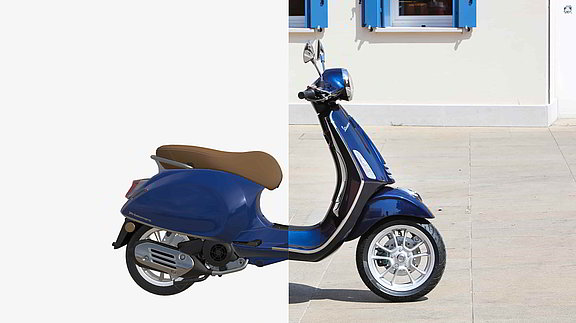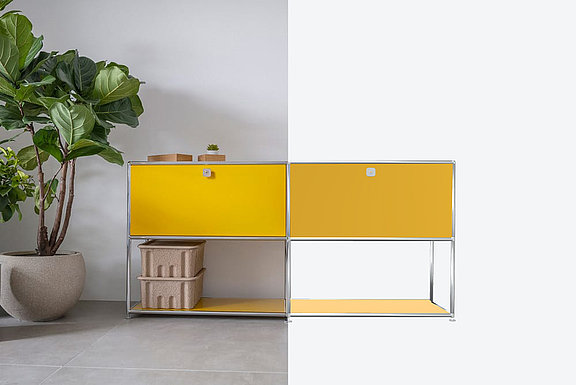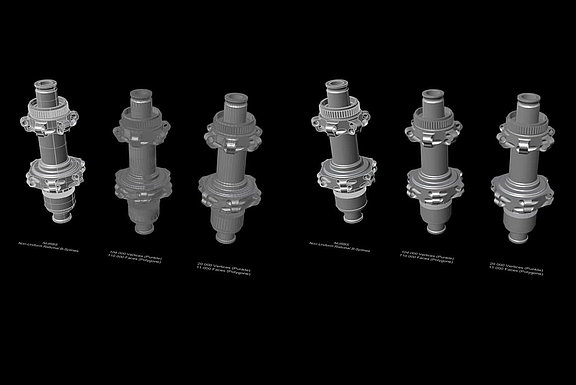Creation 3D model: Which data is suitable?
Author: Matthias Baumgartner
More and more often, you come across manufacturers on the Internet who present their products in 3D. Customers can view the product from all angles, rotate it, and zoom in and out. Without the need for an app, products can also be visualized in their current environment via augmented reality.
But how do you get these 3D models and what source data is needed for this? In this blog article, we go into more detail, explaining the different options and the associated advantages and disadvantages.
What is a 3D model?
By definition, a 3D model is a digital representation of an object or structure in three dimensions. It consists of a large number of points, lines and surfaces that are mathematically calculated and represented in a digital environment. 3D models are used in a variety of industries, including architecture, product development, medicine, entertainment, and 3D printing. 2D objects, on the other hand, are flat and have only one length and width, while 3D objects have depth and are modeled in three dimensions, making them look more realistic and natural.
Why product presentation with 3D model?
Product presentation in 3D enables customers to have an intensive experience with the product or a brand. It helps to present products more vividly, which facilitates understanding and the purchase decision. Positive effects such as increased dwell time, brand building, and an increase in the number of purchases are thus achieved. However, 3D models that are created specifically for these applications are always a prerequisite.
Create 3D models: What output data is helpful?
There are various types of source data for the production of 3D models. You can thus have a web-optimized 3D model created from (almost) anything. However, depending on the source data, this is more or less time-consuming. Moreover, the choice of the right source data can have a significant impact on the quality and accuracy of the final model. In the following, we will give an overview of which types of source data are suitable for the creation of 3D models.
CAD data as a basis for 3D models
CAD data is very often available from a product and is a popular starting point for 3D models.
- Advantage: CAD data can usually be converted directly for a web or configurator application and the geometry can be adopted.
Disadvantage: In practice, the converted CAD models almost always have to be manually reworked and optimized. Since you can't derive materials from a CAD model, they have to be created additionally (surfaces, colors,...).
Possible output formats (excerpt):
- .ASM, .PAR, .PWD, .PSM
- .DWG, .DXF
- .SLDASM, .SLDPRT
- .STP, .STEP,
- …
Photos as a basis for 3D models
Photographs can serve as the basis for creating 3D models by converting them into a digital 3D model through photogrammetric techniques.
- Advantage: Material information can also be taken from the images. By using photographs as reference material, 3D models can be created that reflect the shape, texture and color of the real object or environment as accurately as possible.
Disadvantage: One thing to keep in mind about photographs is that they must include all relevant product details in order to construct them. Details that are not apparent from the photos must be added later or it is not possible to include them in the final model. Poor exposure can affect the rendering and creation of certain materials. Additional communication effort is almost always required to generate optimal 3D models.
Formats: all common image formats

Polygonal data as a basis for 3D models
Polygonal data can form the basis for creating 3D models by defining a digital representation of an object or structure through the use of meshed surfaces.
- Advantage: These source data sometimes have materials included and can thus be used directly for a 3D application on the web.
- Disadvantage: However, these models often have too many polygons. And are therefore not optimized for a high-performance 3D experience, as expected in a configurator with real-time visualization.
Formats:
- .fbx
- .obj
- .glb / .gltf
- .stl
- other formats from Blender or PixYZ Studio are supported
Drawings in vector or raster format as a basis for 3D models
3D models can be designed or "built" manually with the help of drawings. Due to the existing reference data, the design is facilitated and a dimensionally accurate modeling is possible.
- Advantage: Since drawings can be created in vector or raster format in a precise manner, they are well suited as a basis for 3D models, which must also be precise.
- Disadvantage: The same applies here as with CAD data: Material information must be provided subsequently, since it cannot be derived.
Formats:
- .ai
- .3dm
- .step
- .dxf
- .dwg
- other common vector formats and image formats
Physically provided products as a basis for 3D models
Up to a certain size, the product can of course also be physically provided to a 3D service provider.
- Advantage: Since physically all details and materials are well visible, this is very useful for a reconstruction.
- Disadvantage: During construction, certain dimensional deviations can of course occur, especially with geometrically very complex products.
If no digital data is available, this type of manual modeling can be very time-consuming.
As you can see, there are different data that serve for the creation of 3D models. Each format has different advantages and disadvantages. Often you do not have the choice, because for example only images or the product in physical form is available. Basically, however, it can be said that a 3D model can be conjured up from almost any data.

Is a realistic representation of the surfaces, colors... possible?
With many products, one would naturally like to convey the special properties to the customer as realistically as possible. Almost photorealistic results can be achieved by creating the appropriate materials. By using various effects with light or a 3D environment, your product can be ideally staged. Depending on the starting point of the existing data and the skills of the 3D artist, almost photorealistic models can be created. Would you like more information on this topic? Then we recommend the blog article 3D visualization vs. product photography?
Who can create a 3D model for me?
There are several ways to have a 3D model created. It depends on the complexity of the model and the available budget. If you have sufficient expertise, you can create the 3D model yourself. Otherwise, we recommend hiring a professional 3D artist or an agency specializing in 3D modeling. At Combeenation, we offer a 3D service where you can have your desired 3D models created without much effort. You need 3D models? We do the creation for you.
How much does a 3D model cost?
The price for a 3D model depends on various factors, such as the complexity of the model, the geometry and texturing, the purpose of the model and the desired quality. Since we also get this question again and again, we have created a page. In it you can find exemplary 3D-models, which are deposited with a guideline price. So you get an approximate feel for it. Click here for more information about "Prices for a 3D visualization".
How to create a 3D model?
3D modeling is a process of creating digital models of three-dimensional objects. This is usually done with the help of special 3D modeling software that allows the user to manipulate and refine the shapes, colors and textures of objects.
The 3D modeling process usually begins with the creation of a basic model or shape, often referred to as a "wireframe". This is a simple wireframe representation of the object consisting of a collection of lines and vertices. The user can then change the size, shape, and position of these vertices to shape the object.
Once the basic model is created, further details such as colors, textures and surface structure can be added. This is often achieved by applying materials to the model, which can have specific properties such as gloss, roughness or transparency.
Overall, creating 3D models requires a combination of creative design and technical expertise.
3D models for configurators
Interactive 3D models, as we know them from configurators, are integrated directly in the browser and must therefore be displayed smoothly both on the desktop and on mobile devices. To ensure this, real-time optimized 3D models are created. Common programs such as Maya, Blender, 3ds Max, ZBrush, etc. are used for this purpose. How do we proceed at Combeenation? The following procedure is used to create a 3D model for configurators:
- Retopologizing or the modeling from scratch of e.g. CAD data that has been converted into polygon models to achieve an optimized polycount (link to polycount below). That means the model should not have more geometries than necessary. This ensures that the 3D models run smoothly on as many hardware configurations as possible (not everyone has the latest generation of smartphones).
- Creation of PBR (Physically Based Rendering) materials to render surfaces as real as technically possible on the web or in a 3D product configurator in real time.
- When used in a configurator: preparation of 3D data into models which can be displayed modularly in the configurator, allowing the configuration of the final product.
The challenge is often to create the model with as few polygons as possible. However, as much detail as necessary. And that it looks as realistic as possible. The metric for this is the so-called polycount.
Digression: Why Polycount "counts"?
A polygon model consists of polygons, i.e. polygons - many layers of geometric surfaces. The polycount describes the number of these surfaces.
There is no rule of thumb that says how many polygons an optimized model may have. The goal, of course, is to keep them as small as possible so as not to exceed certain limits. There are programs that automatically reduce the surfaces from existing models. In this example you see a NURBS model of a rear wheel hub of a bicycle and two levels of polygon models. Despite reducing the polygons by a factor of 10 (from 110,000 to 11,000), the result is still appealing and sufficient.

Conclusion: Create 3D models for the web
The shift from 2D to 3D content is becoming more and more established and is finding its way into a wide variety of products when it comes to product presentation. Major brands such as Ikea and Apple have been using this technology for many years. 3D or visual commerce is becoming more and more important in the eCommerce sector. It is now easier than ever to create 3D content and integrate it in a 3D viewer in the web store. A 3D visualization enables customers to create a unique shopping experience. Through a possible integration of augmented reality, this experience is further enhanced and can thus become a special unique selling proposition. Especially for many products, a 3D product configuration is necessary to be able to sell them successfully online.
With the Combeenation platform to 3D representation and configurator
Combeenation has a strong focus on the real-time display of products in 3D, combined with a product configurator, for almost 15 years. If you are also thinking about 3D models for your products or the representation by means of a configurator, we can gladly support you.
This might also interest you: